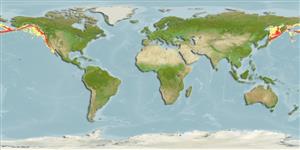>
Gadiformes (Cods) >
Macrouridae (Grenadiers or rattails)
Etymology: Albatrossia: The name of an oceanographic ship "Albatross" (1888-1900) (Ref. 45335); pectoralis: pectoralis refering to the long and narrow pectoral fin (Ref. 6885).
More on author: Gilbert.
Environment: milieu / climate zone / depth range / distribution range
Ökologie
seewasser bathydemersal; standorttreu; tiefenbereich 140 - 3500 m (Ref. 50550), usually 700 - 1100 m (Ref. 56476). Deep-water; 62°N - 26°N, 143°E - 115°W (Ref. 1371)
North Pacific: northern Japan to the Okhotsk and Bering seas, east to the Gulf of Alaska, south to northern Baja California in Mexico.
Length at first maturity / Size / Gewicht / Alter
Maturity: Lm 83.2, range 65 - 102 cm
Max length : 210 cm TL Männchen/unbestimmt; (Ref. 56527); common length : 85.0 cm Männchen/unbestimmt; (Ref. 56527); max. veröff. Gewicht: 86.0 kg (Ref. 56527); max. veröff. Alter: 56 Jahre (Ref. 39270)
Kurzbeschreibung
Bestimmungsschlüssel | Morphologie | Morphometrie
Rückenflossenstacheln (insgesamt) : 2; Rückenflossenweichstrahlen (insgesamt) : 7 - 9; Afterflossenstacheln: 0; Afterflossenweichstrahlen: 131. Snout low, slightly protruding beyond the large mouth, without a spinous terminal scute. Scales small, slightly oblong, with moderate-sized median ridge, without spines or with few weak spinules, and 0 to 5 much lower, non-spinulated ridges laterally on exposed field. Swim bladder small, with 2 retia mirabilia. Gray-brown on head and body, each scale with a prominent dark posterior border, fins and lateral line darker; black in mouth, gill cavity, and on peritoneum (Ref. 6885). Branchiostegal rays: 6-6; pyloric caeca: 12-16;
Young apparently bathypelagic to some degree but become bathydemersal at a size of 50-60 cm (Ref. 1371). Adults feed mainly on cephalopods, fish and shrimps; other food items include ctenophores, echinoderms, worms, crabs, and amphipods (Ref. 1371). Oviparous, with planktonic larvae (Ref. 36385).
Cohen, D.M., T. Inada, T. Iwamoto and N. Scialabba, 1990. FAO species catalogue. Vol. 10. Gadiform fishes of the world (Order Gadiformes). An annotated and illustrated catalogue of cods, hakes, grenadiers and other gadiform fishes known to date. FAO Fish. Synop. 125(10). Rome: FAO. 442 p. (Ref. 1371)
IUCN Rote Liste Status (Ref. 130435)
Bedrohung für Menschen
Harmless
Nutzung durch Menschen
Fischereien: kommerziell
Tools
Zusatzinformationen
Download XML
Internet Quellen
Estimates based on models
Preferred temperature (Ref.
123201): 2.2 - 3.5, mean 2.6 °C (based on 120 cells).
Phylogenetic diversity index (Ref.
82804): PD
50 = 1.0000 [Uniqueness, from 0.5 = low to 2.0 = high].
Bayesian length-weight: a=0.00087 (0.00057 - 0.00133), b=3.26 (3.13 - 3.39), in cm total length, based on LWR estimates for this species & (Sub)family-body (Ref.
93245).
Trophic level (Ref.
69278): 4.3 ±0.7 se; based on diet studies.
Widerstandsfähigkeit (Ref.
120179): sehr niedrig, Verdopplung der Population dauert mehr als 14 Jahre. (tmax >30).
Fishing Vulnerability (Ref.
59153): High to very high vulnerability (70 of 100).
Nutrients (Ref.
124155): Calcium = 10.4 [5.3, 23.0] mg/100g; Iron = 0.303 [0.155, 0.627] mg/100g; Protein = 17.2 [15.5, 18.9] %; Omega3 = 0.226 [0.101, 0.496] g/100g; Selenium = 41 [17, 98] μg/100g; VitaminA = 4.24 [0.83, 19.44] μg/100g; Zinc = 0.232 [0.151, 0.366] mg/100g (wet weight);
